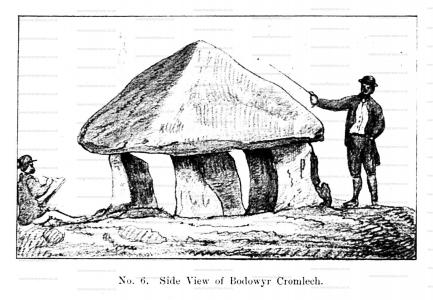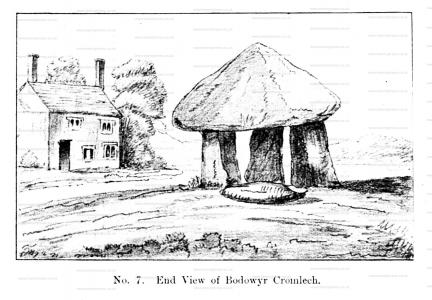Europe, British Isles, North-West Wales aka Gwynedd, Anglesey, Llanfair, Bodowyr Burial Chamber [Map]
Bodowyr Burial Chamber is in Llanfair, Anglesey, Prehistoric Anglesey Burial Chambers.
Bodowyr Burial Chamber [Map]. Lay-by for two cars on the road.
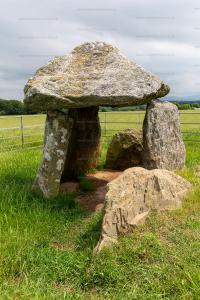
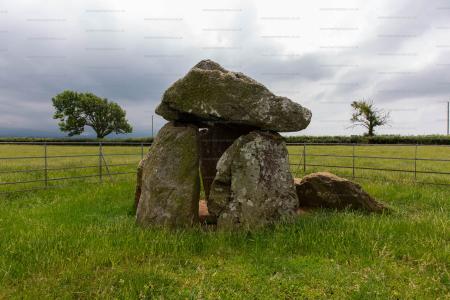
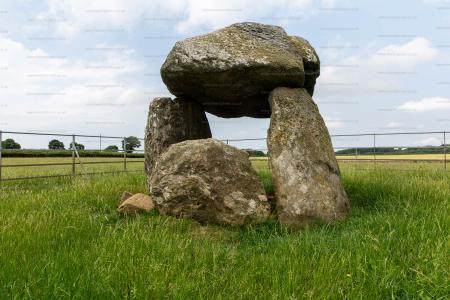
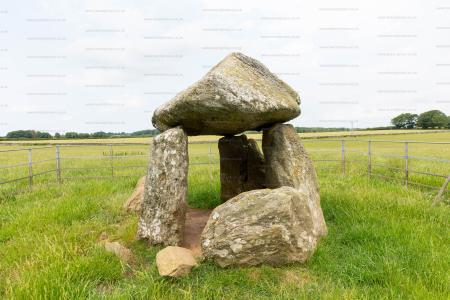
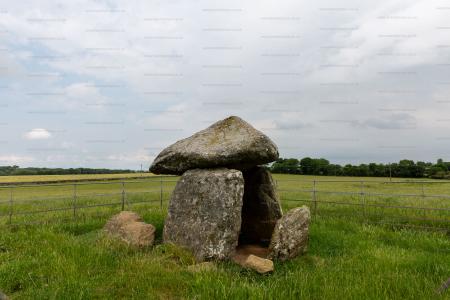
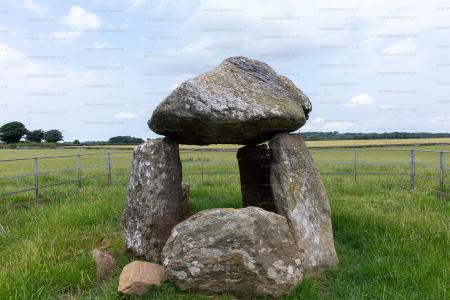
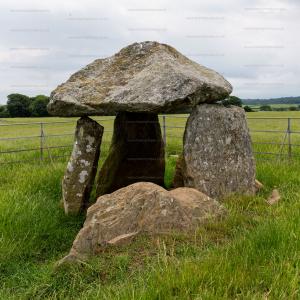
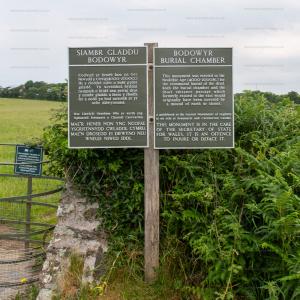
Mona Antiqua Restauranta 93 Druidical Monuments. In the other townships likewise, and on the borders of them, there are to be seen either standing or thrown down, divers monuments of Druidish worship. There is a pretty Cromlech standing at the top of a hillock at Bodowyr [Map], fig. 2. There is also on arising part of the ground, there, the high-way leading through it, the remains of a small cirque,, fig. 3. And on another part of the ground there appear the marks of a Carnedd, the stones of which in times past have been dissposed of into walls and buildings.
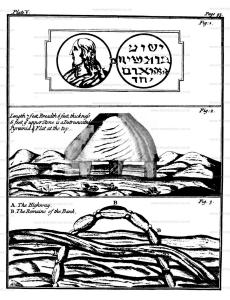
History of the Island of Mona. Llanidan. — This parish, rich in druidical remains, is in the hundred of Menai, distant from Caernarvon five miles, and contains about 3,000 acres of land, generally enclosed, and in a state of cultivation. The resident population 800. The rates in 1803, were £226 95. 2d. at 7s. in the pound, — increased to £452 18s. 0 d. in 1831. This living is a vicarage, valued in the king’s books at £10, and with the chapelries of Llanedwen, Llanddeiniol-Vab, and Llanvair-yn-y-Cymmwd, is in the gift of the lay rector, Lord Boston. The vicar, the Rev. Henry Rowland, having only a third of the tithes. The church, a spacious structure, containing several good monuments, is said to have been built about the year 616, and dedicated to St. Eidan, grandson to Urien Reged. Day of celebration is on September 30. Henry Rowland, D. D. Bishop of Bangor, in 1616, bequeathed a rent Llanidan. — This parish, rich in druidical remains, is in the hundred of Menai, distant from Caernarvon five miles, and contains about 3,000 acres of land, generally enclosed, and in a state of cultivation. The resident population 800. The rates in 1803, were £226 95. 2d. at 7s. in the pound, — increased to £452 18s. 0 d. in 1831. This living is a vicarage, valued in the king’s books at £10, and with the chapelries of Llanedwen, Llanddeiniol-V&b, and Llanvair-yn-y-Cymmwd, is in the gift of the lay rector, Lord Boston. The vicar, the Rev. Henry Rowland, having only a third of the tithes. The church, a spacious structure, containing several good monuments, is said to have been built about the year 616, and dedicated to St. Eidan, grandson to Urien Reged. Day of celebration is on September 30. Henry Rowland, D. D. Bishop of Bangor, in 1616, bequeathed a rent charge £ l 10s. 0 d. on his estate of Plas Gwyn, to be distributed among the poor ; the estate of Llyslew he also left for the support of the free grammar-school, at Bottwnog, which is one of the best farms in this parish. The spacious grove and temple of Tre’r Driw, are now scarcely distinguishable, and only a few of the stones which formed the sacraria, are now remaining to mark out the site. Tre’r Beirdd has almost been demolished. Bodowyr [Bodowyr Burial Chamber [Map]] contains a cromlech, supported by four upright stones, but the circle has been entirely removed. Trevry has only three upright stones remaining, at a great distance from each other ; the foundations have been removed, and the site was levelled by the plough, in 1827. Tan-ben-y-Cevn remains in an entire state, though concealed from observation by the brambles with which it is overspread. Two upright stones only are left at Llyslew. "Caer Leb," or the "moated entrenchment," supposed by Mr. Rowland to have been the residence of the Archdruid, is in good preservation; it forms a quadrangular area, defended by a double rampart, with a broad intervening ditch, and surrounded on the outside by a ditch of smaller dimensions ; within the area are the foundations of square and circular buildings. "In the church1 is a relique, made neither of gold, silver, nor yet ornamented with precious stones, but of very ordinary material — a grit, with a roof-like cover. It might have contained a portion of the saint. Durham possessed his cross, three of his teeth, and his head," &c. Mr. Lloyd, when transcribing a MSS. written by Edward Llwyd, in the Sebright Collection, observes, "Near the latter end of this volume are inserted Mr. Henry Rowland’s answers to Mr. Llwyd of the Museum’s queries, which take in the several parishes of Llanidan, Llanedwen, Llanvair-pwll-gwyngyll, and Llandisilio, in Mona. They contain very little that is remarkable, besides what is to be found in his Mona Antiqua, or in Mr. Llwyd’s notes upon Camden, an account of a strange shower of hail fallen in Mon, on Monday, the 3rd. of May, 1697, which Mr. Rowland communicated to the editors of the Philosophical Transactions, &c. The small osteotheca, in Llanidan church, was found in his time; he conjectures it to be a "Creirgist," or a chest that held relics. It was found about two feet in the ground under the altar, and contained some pieces of bones. He supposes that it belonged to that church, Clunnog, or Llanddwyn, which had their " reliques," and was secretly deposited here during the demolishing proclamations of Edward VI. No corpse could have been buried there before. Mr. Rowland mentions a fine gold medal of Constantine, or Constantius, near the size of a crown piece, found at Trev- Arthur, in Mona, and that it was then in the possession of Sir R. Mostyn, Bart." He quotes towards the last page, the following curious enigmatical epitaph:—
Here lyes the world’s Mother,
By nature my Aunt, — Sister to my Mother,
My Grandmother, — Mother to my Mother,
My Great-grandmother, — Mother to my Grand-mother,
My Grand-mother’s Daughter,
And her Mother:
And all this may be without breach of consanguinity. — "J. Lloyd."
Archaeologia Cambrensis 1854 Page 205. A double Cromlech [Ty Newydd Burial Chamber [Map]],—Close to the house of Trefor, on the road from Beaumaris to Pentraeth, in a field on the south side of the road. They were erect not many years since, but were then thrown down by the tenant, because they were superstitious. (For "they were," read, "he was.")
A double Cromlech [Plas Newydd Burial Chamber [Map]],—In the park of Plas Newydd. This has been often engraved and described. (See Pennants' Tour in Wales; Journal of the Archaeological Institute, &c.) Traces of the carnedd of stones which once covered it are still visible.
Cromlech [Bryn Celli Ddu Burial Mound [Map]],—With passage of stones covered over, at Bryn Celli du, near Plas Newydd. This has been fully described and illustrated in the Archaologia Cambrensis? It is styled Yr Ogof, or the Cave, on the Ordnance map, from its having been always considered so until the superincumbent carnedd was removed. It is now securely fenced off, and preserved from future injury, by the care of C. Evans, Esq., of Plas Gwyn, acting on behalf of the Marquis of Anglesey. This is almost an unique instance of the kind in Wales.
Cromlech,—Near Llanidan Old Church, to the south-west ; it is partly thrown down. Cromlech,
At Bodowyr [Bodowyr Burial Chamber [Map]], near Llangaffo. This is one of the smallest cromlechau known, and is in admirable preservation. (See Journal of the British Archaeological Association.)
Archaeologia Cambrensis 1869 Page 263. Cromlech, Bodowyr [Map], Llanidan.
Honourable Society of Cymmrodorion 1910. The dolmen at Bodowyr [Bodowyr Burial Chamber [Map]], Llanidan, one mile and three quarters W. by N. of the (New) Church, has received a great deal of attention and has been frequently figured.
Rowlands thus describes it:1 "There is a very pretty cromlech standing at the top of a hillock at Bodowyr". He also refers to traces of a carnedd and a cirque close by. Quaint representations of both dolmen and cirque, which looks like the wall of a British village are given. The Rev. J. Davies in a letter, reproduced in Gibson's Camden2, says "This Kromlech at Bod Owyr is more elegant than any monument that I have ever seen of its kind". Writing in 18023 Skinner calls it a very perfect cromlech, the cap sustained by three supporters, each 3 ft. in height and nearly the same in thickness. Miss Llwyd incorrectly describes the capstone as resting on four supporters. According to Griffith, "there were five supports but two have fallen and the capstone at present (1900) rests on three only. The largest dimensions of the cap are 4 ft. 6 ins. by 6 ft. 3 ins. by 7 ft. by 6 ft. The top of the cap is 7 ft. 6 ins. from the ground". It has been marked on all Ordnance Surveys. The capstone still rests on three supporters. A fourth upright has fallen and is partly embedded in the ground, a fifth is comparatively low and does not nearly touch the cap. It is curious that in this instance as also in the case of the dolmen at Pant- y-Saer, to be described later, both monuments have their own sides practically parallel, and one upright in each projects only a short distance above the ground. Hugh Prichard believed that a similar upright was to be found at Ty Mawr cromlech, but after a careful examination I think that the statement is open to doubt. Another similarity between the two monuments is that they both belong to the May-November group. The stones of the dolmen are chiefly composed of mica schist, but one supporter is of hornblende schist. A portion of the last mentioned supporter has become detached and now lies under the capstone.
Note 1. H. R, p. 93.
Note 2. p. 61.
Note 3. 3 J. S., p. 15.
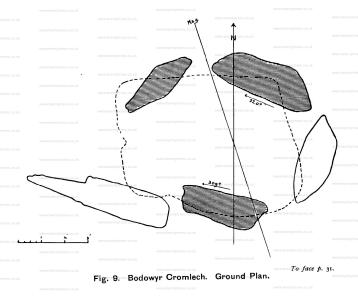
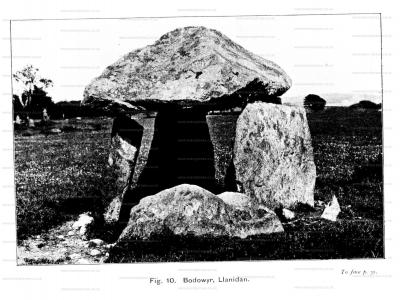
Archaeologia Cambrensis 1908 Supplement 02 December 1802. Here we were gratified by the sight of a very perfect chromlech [Bodowyr Burial Chamber [Map]] standing in a field to the N.W.1 of the house. The upper stone terminates in a ridge like the roof of a building and measures seven feet four inches long three feet deep and four wide this is sustained by three supporters No. 7. End View of Bodowyr Cromlech. each three feet in height & nearly the same in thickness. That cromlechs were not always used (if they were at all) as altars for sacrifice I think may be demonstrated by the one before us (as its Pyramidical form is by no means adapted to the purpose. Indeed there is a tradition amongst the Welsh that this rude memorial was erected over the grave of a British princess named Bronwen who flourished in the year of the world 3105 1).
Note 1. Half a mile south-west.
